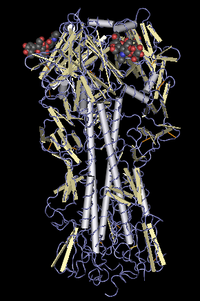H5N1 virus needs to adapt for humans

Scientists find mutations that let bird flu adapt to humans
November 15, 2006
Kawaokaby Terry Devitt
By comparing influenza viruses found in birds with those of the avian virus that have also infected human hosts, researchers have identified key genetic changes required for pandemic strains of bird flu.
The new work, reported in the Nov. 16 issue of the journal Nature, illustrates the genetic changes required for the H5N1 avian influenza virus to adapt to easily recognize the receptors that are the gateway to human cells.
"We identified two changes that are important," says Yoshihiro Kawaoka, the senior author of the Nature paper and a virologist at the University of Wisconsin-Madison School of Veterinary Medicine. "Both changes are needed for the H5N1 virus to recognize human receptors."
The new report provides a molecular blueprint for the genetic changes required to transform a virus that only infects birds to a virus capable of easily recognizing human receptors. Receptors are molecules on the surface of cells that permit the virus to dock with the cell and commandeer it to initiate a cascade of infection. By knowing what genetic changes are required for the virus to easily infect human cells, it may be possible to detect the emergence of pandemic strains earlier, providing public health officials and vaccine manufacturers with precious time to prepare for a global outbreak of highly pathogenic influenza.
To be successful, a virus must be able to recognize and attach to a host cell. But human and avian influenza viruses recognize different cell receptors. Avian flu viruses have demonstrated an ability to evolve to easily infect humans by exchanging genes with human viruses that subsequently permit them to recognize human receptor molecules and gain easy access to cells, typically in the human respiratory system.
The change is thought to occur when human patients are exposed at the same time to a human flu virus and an avian flu virus. Most viruses, including influenza, readily swap genes with one another.
In the new study, conducted by an international team of researchers, the viruses isolated from human patients in Vietnam and Thailand could recognize both human and avian cell receptors. By contrast, the viruses found in chickens and ducks could recognize the receptors only on avian cells.
The work helps flesh out the changes that have occurred in the worrisome strain of avian influenza virus known as H5N1, a strain some fear could be the organism that will trigger a pandemic of virulent human influenza. The avian virus has already changed dramatically from when it was first identified in 1997, says Kawaoka, who also holds an appointment at the University of Tokyo.
"There are big differences between the virus first found in 1997 and the virus we see now," Kawaoka explains. "We are watching this virus turn itself into a human pathogen."
The mutations found by Kawaoka's group have not yet conferred a complete ability on avian flu to easily recognize the topography of human cells, but they are key steps on that pathway. More mutations, says Kawaoka, will be required for the virus to fully adapt to humans, but it is not known how many mutations are needed for such a change.
However, if scientists are able to continue to monitor and secure viral isolates from humans infected with bird flu, they may be able to map a mutation trajectory that will help predict when the avian virus will cross the threshold to become a human pathogen.
The last two flu pandemics in 1957 and 1968 were caused by avian viruses that had accumulated enough genetic mutations to be considered hybrids of animal and human viruses, Kawaoka notes.
The new work was supported by grants from the Japan Science and Technology Agency; the Japan Ministry of Education, Culture, Sports, Science and Technology; the Japan Ministry of Health Labor and Welfare; and the U.S. National Institutes of Health.
Feedback, questions or accessibility issues: comments@uc.wisc.edu
Copyright
© 2005 Board of Regents of the University of Wisconsin System


2 Comments:
Hello everyone very interesting what you write in here Keep up the good work.
Your blog is really nice and full of information if you are looking for a wildlife tour in Corbett so visit on this link and get us soon to make your wildlife tour best in your best destination- Corbett national Park
Post a Comment
Subscribe to Post Comments [Atom]
<< Home